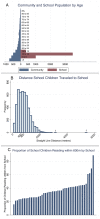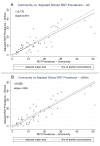Reliability of school surveys in estimating geographic variation in malaria transmission in the western Kenyan highlands
- PMID: 24143250
- PMCID: PMC3797060
- DOI: 10.1371/journal.pone.0077641
Reliability of school surveys in estimating geographic variation in malaria transmission in the western Kenyan highlands
Abstract
Background: School surveys provide an operational approach to assess malaria transmission through parasite prevalence. There is limited evidence on the comparability of prevalence estimates obtained from school and community surveys carried out at the same locality.
Methods: Concurrent school and community cross-sectional surveys were conducted in 46 school/community clusters in the western Kenyan highlands and households of school children were geolocated. Malaria was assessed by rapid diagnostic test (RDT) and combined seroprevalence of antibodies to bloodstage Plasmodium falciparum antigens.
Results: RDT prevalence in school and community populations was 25.7% (95% CI: 24.4-26.8) and 15.5% (95% CI: 14.4-16.7), respectively. Seroprevalence in the school and community populations was 51.9% (95% CI: 50.5-53.3) and 51.5% (95% CI: 49.5-52.9), respectively. RDT prevalence in schools could differentiate between low (<7%, 95% CI: 0-19%) and high (>39%, 95% CI: 25-49%) transmission areas in the community and, after a simple adjustment, were concordant with the community estimates.
Conclusions: Estimates of malaria prevalence from school surveys were consistently higher than those from community surveys and were strongly correlated. School-based estimates can be used as a reliable indicator of malaria transmission intensity in the wider community and may provide a basis for identifying priority areas for malaria control.
Conflict of interest statement
Figures





References
Publication types
MeSH terms
Grants and funding
LinkOut - more resources
Full Text Sources
Other Literature Sources
Medical

